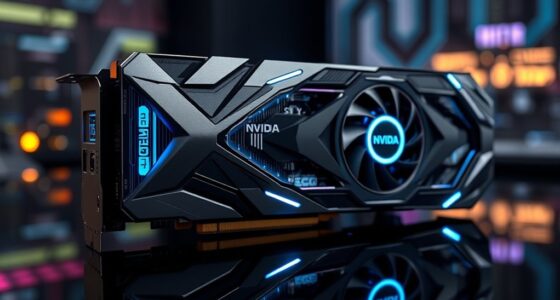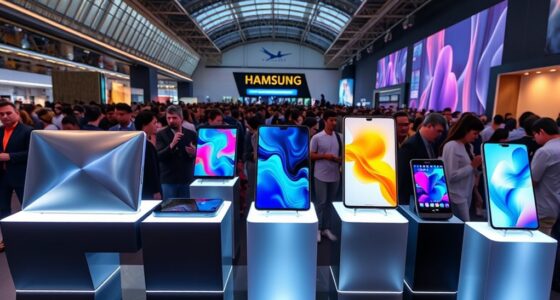USB4 v2 boosts your workflow with faster data transfers up to 80 Gbps, so large files move quickly. It supports high-resolution displays like 16K HDR and 8K at 144Hz, making your visuals sharper. Plus, it delivers up to 240W power, so you can run and charge your devices with fewer cables. These improvements simplify your setup and make multitasking smoother—continue exploring to see how USB4 v2 can elevate your creative projects.
Key Takeaways
- USB4 v2 offers up to 80 Gbps transfer speeds, enabling faster large file transfers for creators.
- Supports 16K HDR displays and 8K at 144 Hz, enhancing high-resolution content workflows.
- Delivers up to 240W power, allowing charging of laptops and peripherals without extra adapters.
- Improves multi-device connectivity with seamless, stable connections through advanced USB-C technology.
- Industry adoption begins in 2025, ensuring future-proof compatibility for creative equipment.
Enhanced Data Transfer Speeds and Bandwidth Capabilities
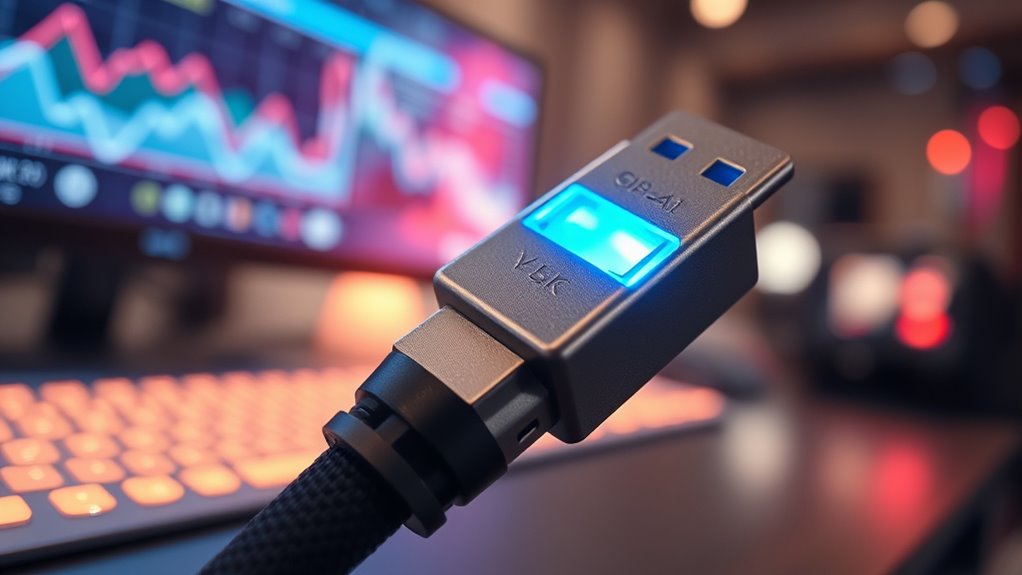
USB4 v2 markedly boosts data transfer speeds and bandwidth capabilities, enabling you to move large files much faster. It supports up to 80 Gbps, doubling the previous maximum of 40 Gbps, using four lanes at 40 Gbps each or three lanes for 120 Gbps. This speed is achieved with existing passive USB-C cables rated for 40 Gbps and new active cables, thanks to a new physical layer architecture that maintains compatibility with USB-C. Understanding the technical specifications helps users better grasp the potential of this advanced standard, especially considering the specialized hardware required for optimal performance. Additionally, the enhanced data capabilities promote active listening and workflow efficiency for creators managing multiple high-bandwidth tasks.
Advanced Display and Graphics Support for High-Resolution Content
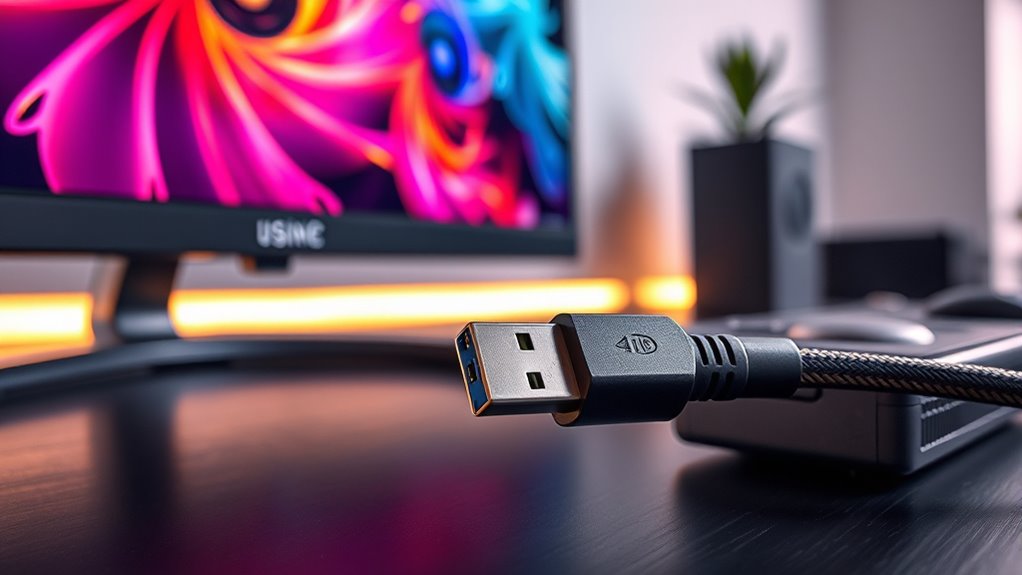
Building on the impressive speed and bandwidth improvements, USB4 v2 elevates display and graphics support to handle high-resolution content seamlessly. It supports DisplayPort 2.1 UHBR20, enabling up to 80 Gbps for video, allowing 16K HDR displays and 8K at 144 Hz without chroma subsampling. Multi-lane signals and full bandwidth tunneling minimize overhead, while asymmetric transmission—3 Tx + 1 Rx—delivers 120 Gbps to the monitor and 40 Gbps for data, perfect for complex workflows. This setup supports high-res displays and fast peripherals simultaneously, streamlining creative tasks. The table below highlights key capabilities:
| Feature | Resolution & Refresh Rate | Data Transfer Rate | Workflow Benefit |
|---|---|---|---|
| DisplayPort 2.1 UHBR20 support | 16K HDR, 8K 144Hz | Up to 80 Gbps | Ultra-high-resolution editing |
| Asymmetric transmission mode | Video: 120 Gbps, Data: 40 Gbps | 120 Gbps out | Dual high-speed display and peripheral use |
| Multi-protocol tunneling | PCIe 4.0 + DisplayPort 2.1 | Simultaneous | Efficient multi-device setups |
Additionally, support for content creation workflows ensures that creators can work with high-quality visuals effortlessly. Enhancements in graphics support further empower creators to handle demanding visual tasks with ease.
Power Delivery Innovations for Creative Equipment
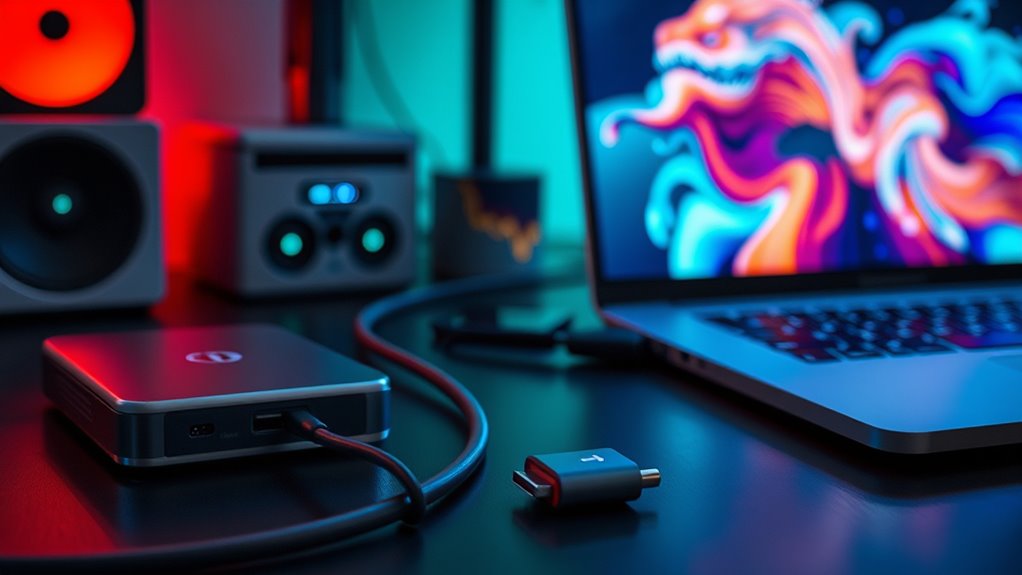
Enhanced power delivery capabilities in USB4 v2 revolutionize how you charge and power creative equipment. Supporting up to 240 watts (48 V, 5 A), it far exceeds previous standards, allowing you to power professional laptops, monitors, and high-demand peripherals without extra adapters. This boost means faster charging, reducing downtime during intensive projects. Certified cables support both 60 W and 240 W configurations, offering flexibility for different devices. The improved system maintains stable voltage and current, vital for sensitive audio-visual gear. Integration with PCIe 5.0 ensures efficient, reliable power management alongside high data throughput. Backward compatibility with USB 3.2, USB 2.0, and Thunderbolt 3 simplifies your setup, enabling a single cable to handle diverse devices safely and effectively—streamlining your creative workspace. Additionally, understanding power delivery standards helps creators optimize their equipment performance and longevity.
Impact on Workflow Efficiency and Multi-Device Connectivity

Thanks to the significant speed improvements in USB4 v2, your workflow becomes more efficient with faster data transfers and streamlined device management. With speeds up to 80 Gbps, you can transfer large files like 4K videos or datasets quickly. Automated validation reduces errors, ensuring stable connections. Support for asymmetric transmission allows faster data flow from your computer to devices, boosting productivity. You can connect multiple devices—monitors, SSDs, peripherals—through a single USB-C hub, simplifying your setup. Enhanced display support with DisplayPort 2.1 enables multiple high-res monitors. The universal port standard minimizes compatibility issues, while improved bandwidth management makes device detection seamless. This combination accelerates your creative process and reduces clutter, making your workspace more efficient. Additionally, understanding power delivery standards helps optimize device charging and power management during intensive tasks.
Industry Adoption and What Creators Need to Know
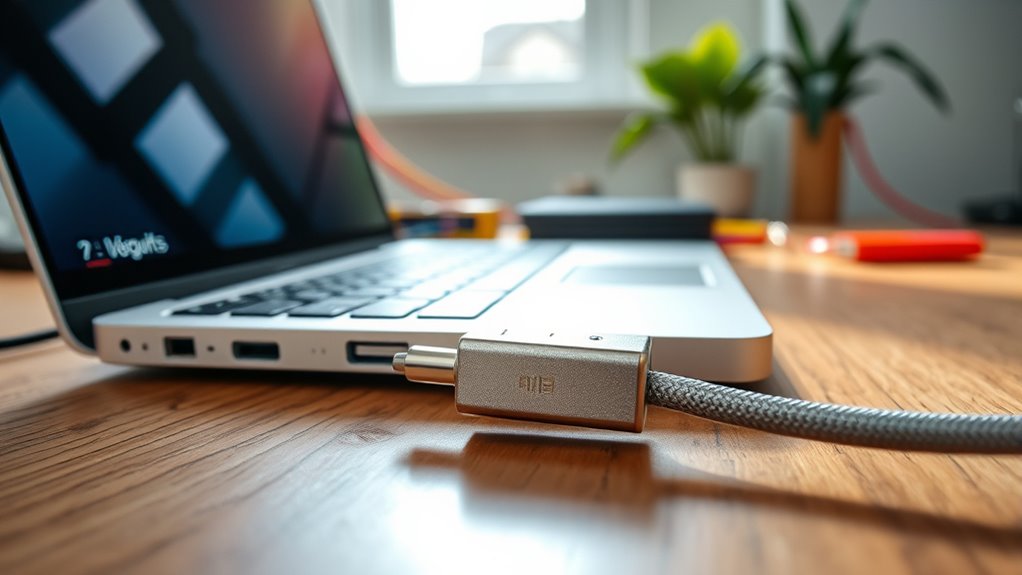
As USB4 v2 products with 80Gbps bandwidth start hitting the market in 2025, industry adoption is accelerating across laptops, peripherals, and hubs. Early adopters like Apple’s MacBook Pro, Razer Blade 18, and Thunderbolt 5 docks are paving the way, although fully certified USB4 v2 devices are still in development. Intel’s Thunderbolt 5 chipset plays a key role in early implementations, ensuring broad compatibility and supporting legacy standards. The demand for high-speed data transfer fuels growth in the USB4 cable market, with companies like Apple, Razer, and Anker driving innovation. As technology advances, controllers from ASMedia and Via Labs are expected around 2027. For creators, this means faster, more versatile connections across devices, enabling more efficient workflows and seamless multi-device integration. Additionally, the Cultural and Regional Breakfasts landscape is evolving with new innovations and regional preferences shaping the way people start their day, reflecting diverse culinary traditions. The increasing integration of security features in USB4 v2 devices further enhances data protection during high-speed transfers, providing peace of mind for users. Moreover, high-speed data transfer capabilities will support emerging creative tools and workflows, empowering creators to work more effectively. As these technologies become more widespread, compatibility standards will play a crucial role in ensuring seamless operation across different devices and platforms. To ensure the security of these rapid data exchanges, implementing cybersecurity measures becomes increasingly important as the technology becomes more widespread.
Frequently Asked Questions
Will Existing USB-C Cables Support USB4 V2.0 Speeds?
If you’re wondering whether your existing USB-C cables support USB4 v2.0 speeds, the answer is generally no. Most current cables support only up to 40 Gbps, which limits their performance with the new standard. To take full advantage of USB4 v2.0’s 80 Gbps, you’ll need cables specifically certified for higher speeds. Until then, your cables will work but won’t maximize the latest speed improvements.
How Compatible Is USB4 V2.0 With Older USB and Thunderbolt Devices?
You’ll find USB4 V2.0 highly compatible with older USB and Thunderbolt devices. It maintains backward compatibility with previous USB standards, so your USB 3.0, 2.0, and legacy devices still work smoothly. Plus, it supports Thunderbolt 3, allowing seamless connection to Thunderbolt peripherals. This means you can connect your existing devices without worry, and enjoy high-speed data transfer and video support, all while preserving compatibility across your peripherals.
What Are the Main Differences Between USB4 V2.0 and Previous Versions?
The main differences between USB4 v2.0 and earlier versions include markedly faster data transfer speeds, doubling from 40 Gbps to 80 Gbps, thanks to new signaling technology. It also supports higher power delivery, potentially exceeding 100 watts, and improves protocol efficiency for handling multiple data types simultaneously. Compatibility remains broad, but USB4 v2.0 offers enhanced performance, better video and peripheral support, making it ideal for demanding creative and professional workflows.
Are There Specific Hardware Requirements to Upgrade to USB4 V2.0?
You might worry about hardware upgrades, but upgrading to USB4 v2.0 mainly requires a host controller with PCI-Express 5.0 x4 support. You’ll also need cables certified for 80 Gbps and possibly active cables for full speed. Devices should support DisplayPort 2.1 for high-res video, and your hardware needs to handle tunneling protocols like USB 3.x, PCIe, and DisplayPort to enable new speeds and features.
How Will USB4 V2.0 Impact Future Creative Device Development?
You’ll find that USB4 v2.0 revolutionizes future creative device development by enabling faster data transfer, higher-resolution displays, and more compact designs. It allows you to create thinner, more powerful peripherals like external storage, docking stations, and multi-monitor setups. You’ll benefit from seamless compatibility with existing devices and faster workflows, reducing wait times. Overall, this upgrade pushes innovation, empowering you to work more efficiently and develop cutting-edge tools tailored for your creative needs.
Conclusion
USB4 v2 is truly a game-changer for creators, transforming your workflow with lightning-fast speeds and seamless multi-device connections. You’ll experience stunning high-resolution displays and powerful charging like never before. It’s like having a supercharger for your creative tools, making your process smoother and more efficient. Stay ahead of the curve, because embracing this technology means stepping into the future where your creativity knows no limits. Don’t get left behind—unlock your full potential today!



